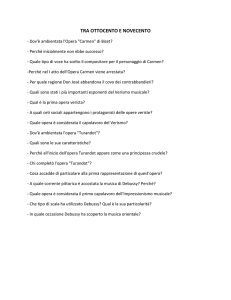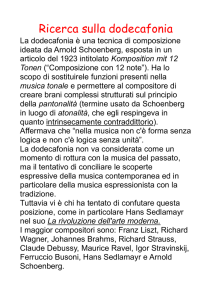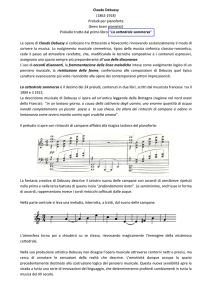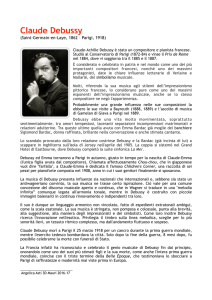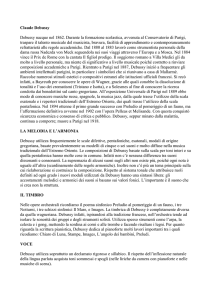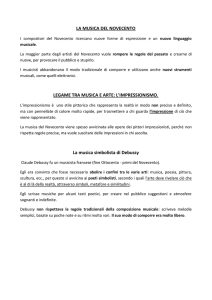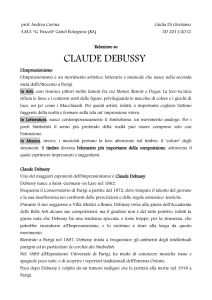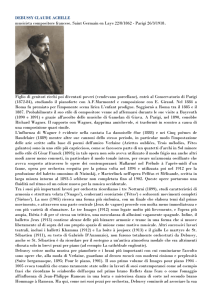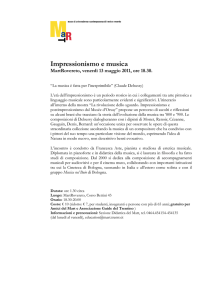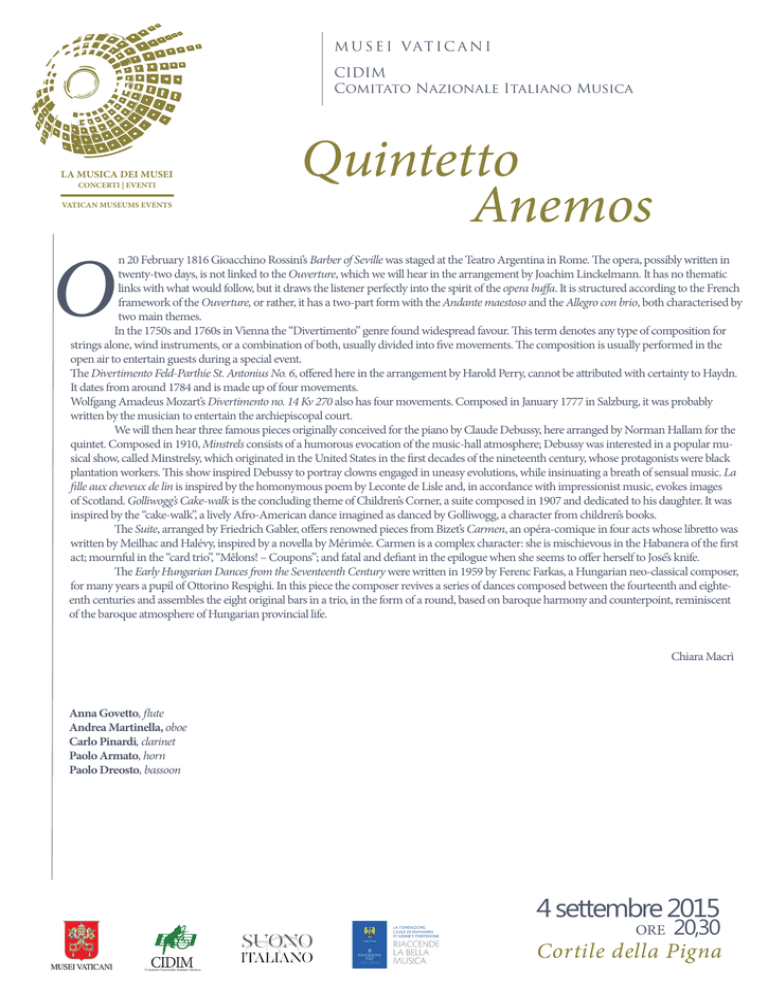
M U S E I VAT I C A N I
CIDIM
Comitato Nazionale Italiano Musica
LA MUSICA DEI MUSEI
CONCERTI | EVENTI
VATICAN MUSEUMS EVENTS
O
Quintetto
Anemos
n 20 February 1816 Gioacchino Rossini’s Barber of Seville was staged at the Teatro Argentina in Rome. The opera, possibly written in
twenty-two days, is not linked to the Ouverture, which we will hear in the arrangement by Joachim Linckelmann. It has no thematic
links with what would follow, but it draws the listener perfectly into the spirit of the opera buffa. It is structured according to the French
framework of the Ouverture, or rather, it has a two-part form with the Andante maestoso and the Allegro con brio, both characterised by
two main themes.
In the 1750s and 1760s in Vienna the “Divertimento” genre found widespread favour. This term denotes any type of composition for
strings alone, wind instruments, or a combination of both, usually divided into five movements. The composition is usually performed in the
open air to entertain guests during a special event.
The Divertimento Feld-Parthie St. Antonius No. 6, offered here in the arrangement by Harold Perry, cannot be attributed with certainty to Haydn.
It dates from around 1784 and is made up of four movements.
Wolfgang Amadeus Mozart’s Divertimento no. 14 Kv 270 also has four movements. Composed in January 1777 in Salzburg, it was probably
written by the musician to entertain the archiepiscopal court.
We will then hear three famous pieces originally conceived for the piano by Claude Debussy, here arranged by Norman Hallam for the
quintet. Composed in 1910, Minstrels consists of a humorous evocation of the music-hall atmosphere; Debussy was interested in a popular musical show, called Minstrelsy, which originated in the United States in the first decades of the nineteenth century, whose protagonists were black
plantation workers. This show inspired Debussy to portray clowns engaged in uneasy evolutions, while insinuating a breath of sensual music. La
fille aux cheveux de lin is inspired by the homonymous poem by Leconte de Lisle and, in accordance with impressionist music, evokes images
of Scotland. Golliwogg’s Cake-walk is the concluding theme of Children’s Corner, a suite composed in 1907 and dedicated to his daughter. It was
inspired by the “cake-walk”, a lively Afro-American dance imagined as danced by Golliwogg, a character from children’s books.
The Suite, arranged by Friedrich Gabler, offers renowned pieces from Bizet’s Carmen, an opéra-comique in four acts whose libretto was
written by Meilhac and Halévy, inspired by a novella by Mérimée. Carmen is a complex character: she is mischievous in the Habanera of the first
act; mournful in the “card trio”, “Mêlons! – Coupons”; and fatal and defiant in the epilogue when she seems to offer herself to José’s knife.
The Early Hungarian Dances from the Seventeenth Century were written in 1959 by Ferenc Farkas, a Hungarian neo-classical composer,
for many years a pupil of Ottorino Respighi. In this piece the composer revives a series of dances composed between the fourteenth and eighteenth centuries and assembles the eight original bars in a trio, in the form of a round, based on baroque harmony and counterpoint, reminiscent
of the baroque atmosphere of Hungarian provincial life.
Chiara Macrì
Anna Govetto, flute
Andrea Martinella, oboe
Carlo Pinardi, clarinet
Paolo Armato, horn
Paolo Dreosto, bassoon
4 settembre 2015
20,30
Cortile della Pigna
ORE
CIDIM
Comitato Nazionale Italiano Musica
M U S E I VAT I C A N I
CIDIM
Comitato Nazionale Italiano Musica
LA MUSICA DEI MUSEI
CONCERTI | EVENTI
VATICAN MUSEUMS EVENTS
I
Quintetto
Anemos
l 20 febbraio 1816 va in scena al Teatro Argentina di Roma Il barbiere di Siviglia di Gioacchino Rossini. L’opera, forse scritta in ventidue
giorni, non ha legami con l’Ouverture, che ascolteremo nell’arrangiamento di Joachim Linckelmann. Il brano non ha legami motivici
con ciò che seguirebbe, ma immette l’ascoltatore perfettamente nello spirito dell’opera buffa. È strutturata secondo lo schema dell’Ouverture alla francese, ossia presenta una forma bipartita con l’Andante maestoso e l’Allegro con brio, entrambi caratterizzati da due temi
principali.
Negli anni ’50-60 del XVIII secolo a Vienna godeva di ampio favore il genere del ‘Divertimento’. Con questo termine si denotava qualsiasi tipo di composizione per soli archi, fiati o misto dei due, articolata di norma in cinque movimenti. La composizione si eseguiva, di solito,
all’aperto e serviva per intrattenere gli ospiti durante un evento speciale.
Il Divertimento Feld-Parthie St. Antonius n. 6, qui proposto nell’arrangiamento di Harold Perry, non è attribuibile in modo certo a
Haydn. È databile approssimativamente al 1784 ed è costituito da quattro movimenti.
Anche il Divertimento n. 14 Kv 270 di Wolfgang Amadeus Mozart è in quattro movimenti. Composto nel gennaio del 1777 a Salisburgo, probabilmente viene scritto dal musicista per allietare la corte arcivescovile.
Arrangiati da Norman Hallam per quintetto, ascolteremo tre brani celebri originariamente concepiti da Claude Debussy per pianoforte.
Composto nel 1910, Minstrels consiste in un’evocazione umoristica dell’atmosfera del music-hall: a Debussy interessava uno spettacolo musicale
popolare, chiamato Minstrelsy, nato negli Stati Uniti nei primi decenni dell’Ottocento i cui protagonisti erano i negri delle piantagioni. A questo
spettacolo si ispira Debussy nel ritrarre dei pagliacci dediti ad evoluzioni trepidanti mentre insinua un soffio di musica sensuale. La fille aux cheveux de lin è ispirato all’omonima poesia di Leconte de Lisle e, in acccordo con la musica impressionista, evoca immagini della Scozia. Golliwogg’s
Cake-walk è il brano conclusivo del Children’s Corner, una suite composta nel 1907 e dedicata alla figlia. È ispirato al “cake-walk”, vivace danza
afroamericana che si immagina ballata da Golliwogg, personaggio di libri per bambini.
La Suite, arrangiata da Friedrich Gabler, ripropone celebri brani tratti dalla Carmen di Bizet, l’opéra-comique in quattro quadri su
libretto di Meilhac e Halévy e ispirata a una novella di Mérimée. Carmen, è un personaggio complesso: è maliziosa nell’habanera del primo atto,
funerea nell’Aria delle Carte, fatale e spavalda nell’epilogo quando sembra offrirsi al coltello di José.
Antiche danze ungheresi dal secolo XVII sono scritte nel 1959 da Ferenc Farkas, compositore neoclassico ungherese, allievo per molti
anni di Ottorino Respighi. In questo brano il compositore recupera alcune danze composte tra il XIV e il XVIII secolo e monta le otto battute
originarie in un trio, in forma di rondò, basandosi sull’armonia e sul contrappunto barocco, nel tentativo di creare una reminiscenza dell’atmosfera barocca della provincia ungherese.
Chiara Macrì
Quintetto di fiati Anemos
Anna Govetto, flauto
Andrea Martinella, oboe
Carlo Pinardi, clarinetto
Paolo Armato, corno
Paolo Dreosto, fagotto
4 settembre 2015
20,30
Cortile della Pigna
ORE
CIDIM
Comitato Nazionale Italiano Musica

